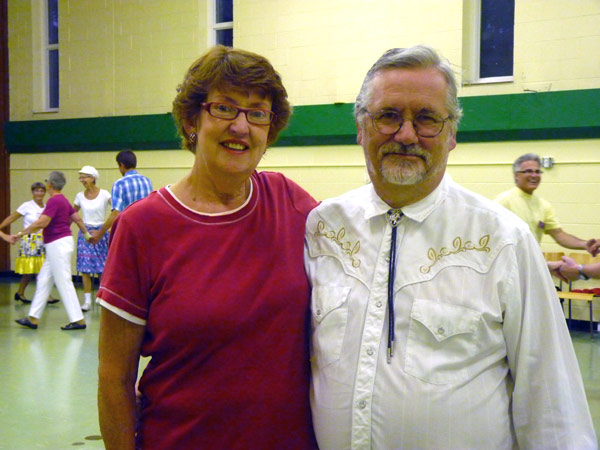Story and photo by Judith van Berkom –
Francois Desmarais and Barbara McClelland had been involved in various types of dance for years when McClelland started to look for something new. When she found Meri Squares on-line – and on the street where they lived – McClelland insisted they had to try it out.
She told her husband: “You have to come with me and if you don’t like it, you don’t have to stay.”
That was back in 1997, and they have never looked back.

“I was one of the young ones back then,” says Desmarais, who was 57 at the time. He grew up learning how to dance from his sisters.
“[Social or couples] dancing died with my generation,” he says, explaining that it represents the kind of commitment many people today are not willing or able to make.
Done in groups of eight, modern square dancing involves cooperation, and understanding of what the other seven dancers are doing, interpreting the calls and immediately dancing the steps.
Starting in a dancer’s first year, two to three new moves are taught each week. By the end of December, 30 different moves have been covered and at the end of the first ‘Basic’ year, a total of 45 to 50 moves have been presented – albeit not yet mastered. It definitely keeps the participants active and engaged.
“You’re exhausted,” says Desmarais. The summer break gives the dancers time to recover, practice and gain confidence.
A solid foundation is needed before moving on to the next level, which is referred to as Mainstream. McClelland explains how important it is to attend every week, and how frustrating it can be if you’re not ready for Mainstream – for you and for your fellow dancers. It’s possible to repeat the first year, and many do. The caller decides if the dancers are ready to level up.
Mainstream dancing involves an additional 15 moves, and people often stay in Mainstream. ‘Plus’ is the next level up – this is the level at which Desmarais and McClelland dance – and involves another 20 complex moves. Plus-level dancing takes place at the same time and location on Thursday evenings.
“Modern square dancing is very different from traditional square dancing, with its preset patterns, calls such as ‘Birdie in the Cage’ where dancers know all the moves and traditional music,” explains Desmarais. “And there’s always an element of surprise.”
Contemporary music is used – music specific to the group it serves, not what you would hear on the radio today.
Desmarais has a background in music. He plays bass guitar and keyboard, and has been involved in music all his life. It was this life-long love of music that ultimately led him to start training to become a caller five years ago.
“You have to know an awful lot about music and rhythm,” says McClelland.
When Desmarais started calling, a famous caller – who had been calling for over 20 years – told Desmarais that he spends 6 to 7 hours a day planning music and moves for the square dancing.
“I couldn’t believe it then, but shortly after I believed him,” says Desmarais. “It takes up all your leisure time. You listen to other callers, take notes, build in new ideas,” he adds.
McClelland is amazed at how many friends you meet in square dancing. It’s no wonder that Meri Squares’ motto is Fun, Fitness, and Friendship.
“They may not be close friends, but you see them every week. You go to other clubs throughout the year in the area and everyone is so welcoming. You’ll have a good time,” she says. “Come out and give it a try.”
Meri Squares celebrated its 45th anniversary in 2014.
Every Tuesday evening from 7:30 p.m. to 9:30 p.m. couples and singles meet for Basic or Mainstream instruction at the Westminster Presbyterian Church Hall at 470 Roosevelt Ave., a block from Richmond Road. On Thursday evenings, the Plus dancers meet at the same location, same time.
For more information and photos go to merisquares.ca.
October 1 is National Seniors Day. Do you know any local senior citizens who have a great story to share with our readers? Contact us!
